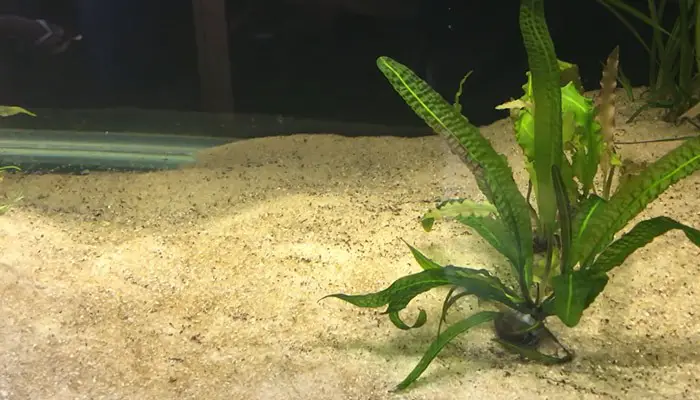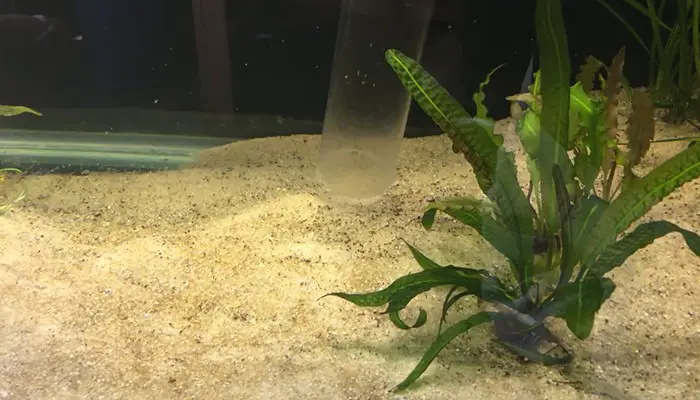5 Reasons For Black Spots In Aquarium Sand [Solution]
Do you want your fish tank to look more natural? Then choose the aquarium substrates. Undoubtedly, they are the best option for a natural look.
What’s more, aquarium substrates have many types. To be more specific, aquarium sand is synthetic silica-based sand with a mixture of coral, crushed quartz, and minerals. But most people prefer the aquarium sand since it gives the fish tank a natural look and is easy to clean.
Now the question: Why do they see black spots in aquarium sand?
There are multiple reasons for aquarium sand going black. The main reasons are- black beard algae, waste food, and other substances, color discharged from different decorations, lack of oxygen, and high manganese and iron levels.
This article will explain why the sand substrate turns black in your fish tank. But wait- there’s more; you will also find out the effects and solutions of black spots in aquarium sand and how to prevent it in this article.
So, let’s begin without further delay-
Why Does The Aquarium Sand Turn Black?

1. Black Algae
Although black beard algae or brush algae belong to the red algae family, their color is not red. Instead, it looks dark green or deep black. It becomes hairy when it grows longer.
Black algae can be primarily seen in fish tanks. So, naturally, it is a common problem for those who own aquariums. Moreover, the black algae are stubborn and cling firmly to the ground or sand bed. As a result, it is challenging to get rid of black algae.
However, firstly you need to know what causes black algae to grow in your aquarium. Check out the points below to understand the reasons-
- Fish tank with excessive plants and aquatic species.
- Irregular water change.
- Lack of carbon dioxide (CO2) in the fish tank water.
[The black algae can separate carbon from hydrogen carbonate. So, if the tank water lacks enough CO2, the black algae takes carbon from hydrogen carbonate ion and grow efficiently and faster than other plants.]
Effect
Although black algae is not a toxic substance, it can be harmful to fish. The aquarium plants cannot complete the photosynthesis process without enough light, and black algae prevent the plants from absorbing sunlight. But that’s not all; too many black algae cause an imbalance in the aquatic environment.
Solution
Black algae are not easy to clean from the sand substrate. So, it’s always a brilliant idea to maintain the fish tank properly. However, if you have already got black algae in your fish tank, here’s the deal for you-
- Phosphate usually helps to increase black algae. So, change the water regularly and try to use phosphate-free water.
- Add a phosphate-absorbing filter to your fish tank. (Our pick: Seachem PhosGuard)
- Clean the waste, food, and dirt.
- Some fish and aquatic animals eat algae. Believe it or not, they will be a great help to you.
- Carbon dioxide deficiency often increases black algae. So, injecting CO2 into the tank water is probably one of the straightforward ways to get rid of black algae.
- Hydrogen peroxide works against black algae. So, wash the affected area with 3% hydrogen peroxide solution.
2. Waste Food And Dirt
This cause is pretty much easy to understand. Waste food and fish poop make a layer with the aquarium substrate.
If you don’t clean your fish tank water and aquarium sand from time to time, it will increase fungal pockets and anaerobic bacteria. As a result, the aquarium sand gets black spots.
Effect
Anaerobic bacteria and fungal pockets reproduce many harmful gasses such as hydrogen sulfide. These gasses cause a nasty smell and create a toxic environment for the aquatic species in the fish tank. What’s more, you will hate if your aquarium looks ugly because of the dirt.
Solution
There are plenty of ways that you can remove all the leftover food from your fish tank. For this purpose, follow the ideas below-
- Don’t give excess food to the fish. It is always a smart idea to avoid trouble.
- A gravel cleaner is the handiest object to clean the dirt. Attach a pipe with a gravel cleaner body and take a bucket where the gravel cleaner can release the waste through the pipe. Now you see no black spot at all.
- Some aquatic animals (snails) eat food from the bottom. So, you can add them to your fish tank to prevent wasting extra food.
- You can also remove black spots with a fishing net or by scooping dirt and waste food in the fish tank.
- If you don’t want to use any tool, use your hands to clean the sand substrate.
I have some suggestions for the best aquarium cleaner. Try them out!
- GreenJoy Aquarium Fish Tank Cleaning Kit
- Laifoo Aquarium Siphon Vacuum Cleaner
3. Dye Elements Of Colored Substrates
Have you ever wondered that the black spots in aquarium sand may come from all the colorful decorations of the fish tank? Yes, you hear me right. Dye-colored substances may cause the sand substrate turning black.
The sand, stone, and shells sometimes contain artificial colors. If they release those dye elements into the water, you may find the aquarium sand brown or black.
Effect
Although dye elements contain some chemicals, they don’t necessarily cause any harm to the fish. But excessive chemicals may release toxic gas.
Solution
Color released from fish tank decorations is a common problem. If your aquarium sand gets black spots from dye elements of decorations, you can vacuum the upper layer of the sand.
Usually, vacuum cleaning almost cleans all the black spots caused by dye elements, if still you are not happy with this, add a new layer of aquatic sand over the sand bed.
4. Lack Of Oxygen
One of the common causes of black spots in aquarium sand is the lack of oxygen. Let me be straightforward: Dead aquarium plants, fish slime, waste food, and bacteria release phosphate (PO4) into the water. As a result, PO4 reacts with O2 and causes a lack of oxygen.
Low oxygen level increases microbial metabolic activity and hydrogen sulfide production. So, it causes the aquarium sand to go black and get a rotten egg smell.
Effect
The high phosphate level creates a poor environment in the fish tank. Moreover, the lack of oxygen is not suitable for fish and other species.
Solution
To keep the balance of oxygen level, the best solution is to change the water regularly. You have to clean the sand bed and add fresh water to remove the black spots in the aquarium.
5. High Manganese And Iron Level
Regular tap water contains different types of minerals. So, high levels of manganese and iron sometimes leave black sediments on the sand bed. As a result, it looks black.
Effect
Although the high level of minerals causes no serious harm, keeping the fish tank clean and changing the water is always safe.
Solution
If the aquarium sand turns black because of the high level of minerals, then follow the steps below-
- Take the aquatic pets out of the aquarium.
- Place them temporarily somewhere else (in a bucket with freshwater).
- Vacuum clean or scoop the black materials of the sand bed.
- If the decorations get black spots, bring them out and clean them with hot water and vinegar.
- Add filtered or RO water in your fish tank.
- Bring your pets back to the aquarium.
How Will You Prevent Aquarium Sand From Turning Black?

Nevertheless, black spots in aquarium sand are not something great that you want to see. However, different causes behind black spots require other methods to clean up.
But first of all, you must identify the reason for aquariums becoming black. For instance, if you see black spots in your fish tank and smell like rotten eggs, then definitely it’s for the polluted water and waste substances.
Take out some black-spotted sand and mix it with alcohol to simplify it. If the sand turns reddish, then it’s black algae. On the other hand, if those black spots look hairy and fuzzy, they are black beard algae.
You can follow some general methods to prevent black spots in the aquarium sand-
- A good setup is essential for a fish tank to prevent black spots.
- Cleaning and maintenance of the fish tank are the keys to keeping the sand substrate spot-free.
- If the tap water contains phosphate, you need to change it with RO water.
- Vacuum the substrate regularly to eliminate the dirt from the sand.
- It would also be best if you cleaned the tank rocks and other decorations to make the aquarium more hygienic.
- Check out the chemical level of the fish tank from time to time.
- Lack of sunlight also helps different bacteria and algae growth. So, taking out the fish tank with your aquarium pets under sunlight will prevent the sand substrate from turning black.
Frequently Asked Questions
What causes aquarium sand to turn black?
The aquarium sand substrate can turn black for many reasons. In most cases, black algae cause these black spots. In addition, if you don’t change the water and clean the fish tank regularly, the sand gets black holes because of fungal pockets and bacteria.
How do I remove black spots in aquarium sand?
Proper cleaning and vacuuming are more than enough if you find black spots in the sand substrate for typical causes like dye decorations, waste food, or minerals. On the other hand, if black algae are the reason, then you have to –
Inject CO2.
Clean dirt and uneaten food.
Control phosphate level.
Use hydrogen peroxide solution.
Conclusion
properly maintaining the fish tank is indeed crucial for a better aquarium environment. It prevents black spots from the sand substrate and keeps the whole fish tank hygienic.
This article covers all the reasons for black spots in aquarium sand and their effects and methods to get rid of them.
We hope that this article didn’t disappoint you and that you found solutions to all your problems here. To sum up, take care of your fish tank, and you will get a satisfying result at the end of the day.
- 7 Reasons For Anubias Leaves Turning Yellow [Solution] - February 3, 2024
- Types & Sizes Of Aquarium Explained: Guide To Pick The Best One - January 27, 2024
- 15 Best Carpeting Plants For Aquascaping -Beginner’s Pick - January 11, 2024

